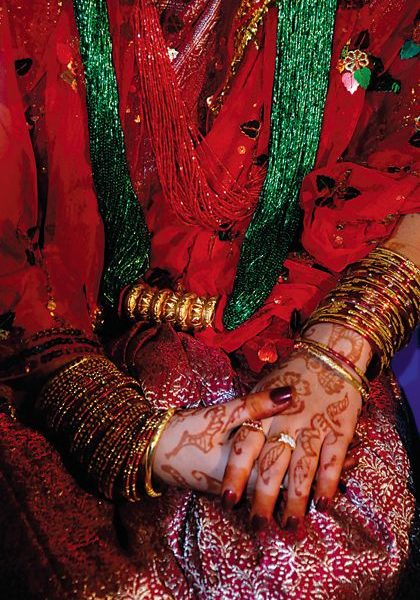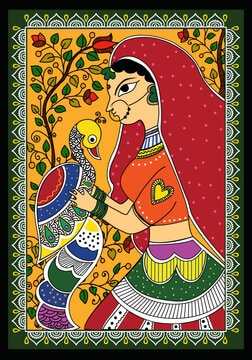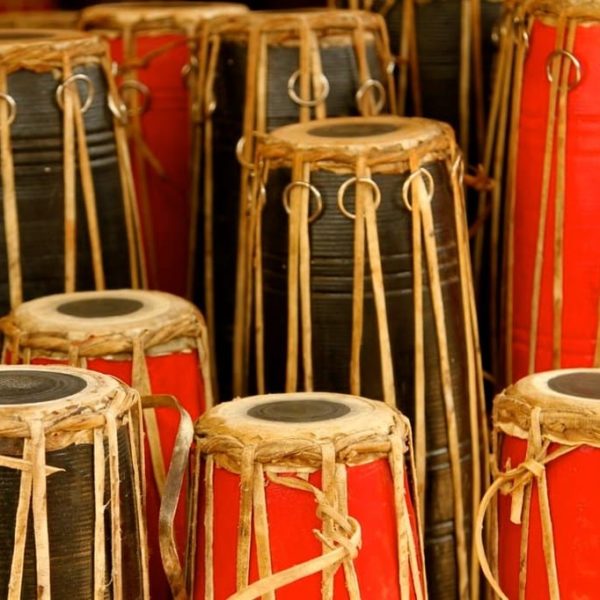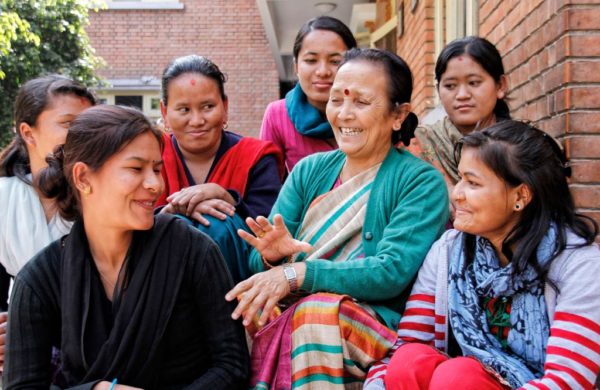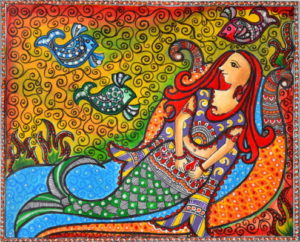
This art is a strict monopoly of the women of Mithila.They cover their courtyard walls in abstract images in brilliant colour, resembling in form and function the sand paintings of the Navahos. The art is a kind of traditional painting that reflects the natural environment including animals, people, life style, tradition and culture of the local people.
The art of Mithila is linked to religious ceremonies, particularly marriage and its consequence, procreation. Interspersed with the Vedic marital rites, with the Sanskrit chanting by the Brahmins, is a tradition controlled by the women and devoted to female deities Durga, Kali and Gauri. During marriage ceremony the bride and groom are pulled away by the women for their own ceremonies devoted to Gauri in which men other than the groom are forbidden. Gauri is the goddess to whom the bride has prayed since childhood to bring her a good husband. These ceremonies are performed in courtyards before painted images of the goddesses. The function of the paintings being ritualistic the art is very symbolic. The primordial energy of the universe is embodied in various female forms, both living women and Goddesses.
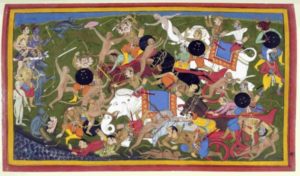
image source: wikimedia

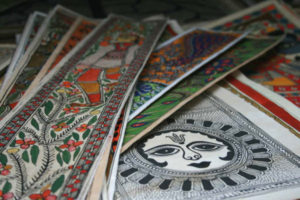
As the wedding ceremony is a special occasion in Maithili society, which is also known as “Kohabar” within thecommunity, a separate room is set and decorated tastefully with several arts for its celebration. This painting is done in the inner as well as outer walls of the Kohabar Ghar (honeymoon house). As a popular social practice, its main motto is to increase the sexual potency and fertility of both the bride and bridegroom. This special painting is drawn on the walls of the house in three places: the Gosaighar (special room for family god), the Kohabar Ghar (honeymoon room) and Kohabar-Gharak-Koniya (corridor or outside of the Kohabar Ghar).
These paintings are wonderfully depicted by the illiterate woman folk of Mithila, and are quite attractive to look at. They express their artistic sentiments and skills on various occasions. The outer walls of the Kohabar are decorated with the paintings of rural life such as a palanquin with its carriers, shady fruit trees like those of mango, banana, Kadamba and Ashoka. They also paint love-scenes of Lord Krishna with the gopinis and his constant companion, Radha.
Some common themes in mithila arts include the Snake goddess, a form in which snakes are worshipped at Nag Panchmi during the monsoons, a time when snakes abound. Durga astride her tiger is another common representation. Probably the most powerful symbolism is the one associated with Duragoman Puren. A single seed that is dropped in the pond produces many lotus flowers, an appropriate thought for the bride and the groom at the time of their wedding. Lakshmi, the Hindu Goddess of wealth, is a newer and common addition to the repertoire of Mithila symbolism. Among the male deities Ganesha, Krishna and Shiva are more commonly depicted. Trees, birds and animals are extensively used in combination with other ritual and religious paintings. Sometimes, rarely, one will see these alone without religious implication.
The painting tradition varies from caste to caste. The art of Brahmins and Kayastha is closely tied to religious ritual, as exemplified in the making of aripana.
To make aripana a woman grinds rice with some water into a paste called pithar. Dipping two fingers into the pithar, she makes graceful lace-like designs on the mud floor of her home or courtyard. She then dots the designs with red powder. Women have a repertoire of such designs that may be drawn for worship of the house deity or for rituals related to marriage or a particular full moon day. The arts of the women are transient. Rains destroy the mud and painted designs or in the spring during a New Year festival, paintings are covered over with mud.
Aripan: paintings of Mithila The Aripanas are drawn by various female members of the household, on ritually prescribed occasions, on the clean swept ground of the courtyards or inside the house.
The Aripan painting, derived from Sanskrit “ Alepan” (meaning “to smear”), is quite auspicious in the whole Mithila region. It basically refers to smearing the ground with cow dung and clay for ritual purification. Also known as “Mandala”, this art form comes into play on several religious occasions such as Brata Bandha (sacred thread ceremony), Chhatiyar (sixth day rites of a child after birth), Mundan (head shaving ceremony of a child), puberty, conception, initiation into learning, and marriage. Interestingly, this art is also practiced in various parts of India under different names like “Alpna” in West Bengal, “Mandala” in Rajasthan and “Rangoli” in Gujurat. In Nepal’s Bhojpuri areas, it is known as “Chaukapurna” while in Mithila, it is “Aripam’.
This Tradition of Aripan is found in Grihyasutra too. The Vastu Purusha Mandala is a schematic mental map, and the basis for nationalizing any site. It is not a measured drawing or a contour map, but a code that enables reading of the site and a resolution of its design. A piece of land, once assigned for a dwelling, becomes the Mandala within which the world of a man is organized. Its features become the Mandala, which in turn adopts its shape and terrain. The concept of the Vastu Purusha Mandala acts through a site without which it remains physically nonexistent, which means that an ordered field cannot exist without a field.
Aripan is drawn and depicted both for adornment and purification of a piece of ground. It is painted either on the main entrance gate of a house, or at thresh-holds and courtyards. Sometimes, it also finds place in the main residential room. Both young and old women are talented at this particular art form.
There are many kinds of Atipan art which are depicted and drawn for various purposes. One kind of Aripan is drawn on the auspicious occasion of Tusari Pooja in which young, unmarried Maithili girls draw it to get good husbands. Its duration is between Makar Sankranti and Falgun Sankranti. In this Aripan they draw a temple, the moon, sun, navagrah (nine planets and so on. Likewise, Sanjha Aripan, which is depicted in honor of Sandhya Devi (goddess of the evening) . And the whole cosmos are drawn and shown in the form of a temple. Panch Dev (five gods) and Shapta Rishis (seven sages) are also sketched in the shape of the lotus Aripan.
Similarly, Sasthi-pooja-Aripan is painted when young girls start menstruation. This Aripan signifies the creation and destruction of the universe. The Gatra-Sankrant Aripan is the symbol of birth and death, whereas the Kojagara Aripan is drawn on the leaf of Makhan on the full moon-day of Aswin (September). Diwali Aripan, which is known in Mithila region as Sukha-ratri Aripan, is depicted to welcome laxmi, the goddess of wealth. And Swastik Aripan is painted for blessing the young generation.
Aripan art is cosmic in nature and playful in expression. It is a bright and beautiful art. The material applied in such art is a mixture of powdered rice and water, known as “pithar”. The women folk, dipping two fingers into the pithar, produce graceful geometrical diagrams with different designs on the mud floor of their housed and courtyards and at the thresholds. This art tells of the magnanimity of the mother goddess
In order to make it more adorning, the women also smear red powder on it. Moreover, three inner triangles symbolize gauri, the favorite goddess of the Maithil maidens.
The Aripanas are drawn by various female members of the household, on ritually prescribed occasions, on the clean swept ground of the courtyards or inside the house.
Ideally, the design of an Aripana should be revealed to the lady-artist as a result of meditation and general yogic experience.
In practice, the details of the various Aripanas are learned by girls from watching the work of their mothers, grandmothers and other female relatives and neighbors”.



